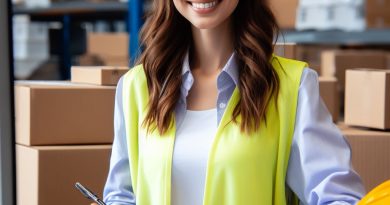Historical Evolution of Train Conductors in the US
Last Updated on November 25, 2023
Introduction
The role of train conductors in the US transportation system has been significant throughout history. Railways in the US have a long and rich history.
Train or railroad conductors play a crucial role in the US transportation system, ensuring safe and efficient rail operations.
They manage schedules, supervise boarding, and enforce safety protocols.
Conductors coordinate with the crew, handle emergencies, and communicate with control centers.
Their active involvement ensures smooth train journeys, minimizing delays and ensuring passenger safety. In freight transport, conductors oversee cargo loading and unloading, contributing to the timely delivery of goods.
With a focus on safety and adherence to regulations, railroad conductor are essential for the reliability and effectiveness of the US rail network.
Their proactive role in daily operations underscores their significance in maintaining the integrity of the country’s transportation infrastructure.
Railways in the US began in the early 19th century. Entrepreneurs like Peter Cooper pioneered steam locomotives.
The Baltimore and Ohio Railroad, the first commercial line, opened in 1830. Expansion accelerated, connecting cities and boosting economic growth.
The transcontinental railroad, completed in 1869, linked the East and West coasts. Railways played a crucial role in westward expansion, transporting people and goods.
The industry faced challenges like competition with automobiles and airplanes. Despite this, railways remain integral to freight transportation.
Today, Amtrak provides passenger services, maintaining the nation’s railway legacy.
Early Years of Train Conductors
During the early years of train travel in the United States, train conductors played a crucial role in ensuring the safe and efficient operation of the railways.
Role of Early Train Conductors
- Collecting fares and tickets from passengers was one of the primary responsibilities of early railroad conductor
- They also maintained order on the trains, ensuring that passengers boarded and alighted the train safely.
- Train conductors were responsible for overseeing the loading and unloading of cargo at each stop.
- They communicated and coordinated with the engineer and other crew members to ensure a smooth journey.
Challenges Faced by Early Train Conductors
- One of the major challenges early train conductors faced was dealing with rowdy and often intoxicated passengers.
- They had to handle difficult situations, such as disputes between passengers and enforce rules and regulations on board.
- Weather conditions presented another challenge, as conductors had to work in extreme heat, cold, rain, and snow.
- Long hours and irregular schedules often made the job physically and mentally demanding for early railroad conductor
Evolution of Train Conductor Uniforms
The uniforms worn by train conductors have evolved significantly over the years.
In the early years, conductors wore practical attire that was suitable for the demanding nature of their work.
However, as rail travel became more popular and the role of conductors became more formalized, the uniforms began to change.
By the late 19th century, railroad conductor started wearing distinctive uniforms that set them apart from other railway employees.
These uniforms included a jacket with brass buttons, a conductor’s hat, and sometimes a pocket watch as a symbol of authority.
Throughout the 20th century, the materials and design of train conductor uniforms continued to evolve in line with fashion trends.
Today, railroad conductor often wear contemporary uniforms that reflect the style and branding of the railway company they work for.
Basically, the early years of railroad conductor in the United States were marked by their essential role in railway operations.
They faced various challenges, including maintaining order and dealing with unruly passengers.
As rail travel grew, so did the importance of conductor uniforms, which became a symbol of authority and professionalism.
The evolution of these uniforms showcases the changing perception and significance of railroad conductor in American history.
Growth and Expansion of the Railways
Impact of the Industrial Revolution on the Railway System
- The Industrial Revolution sparked significant advancements in the railway system.
- Improved technology and machinery allowed for the construction of longer and more efficient railways.
- Steam-powered locomotives replaced horse-drawn carriages, revolutionizing transportation.
- The railways became crucial for the transportation of goods and people across the expanding nation.
- The demand for reliable and skilled railroad conductor grew rapidly.
- Railroad conductor played a vital role in ensuring the smooth operation of the railway system.
Increase in the Number of Train Conductors
- As the railway system expanded, the need for railroad conductor increased significantly.
- Railway companies hired more conductors to meet the growing demand for transportation.
- Train conductors were responsible for overseeing the safe passage of trains and managing passenger affairs.
- They ensured that trains adhered to schedules and handled ticketing and passenger assistance.
- Train conductors were highly respected and considered essential members of the railway workforce.
Introduction of Specialized Conductors for Different Types of Trains
- With the development of different types of trains, specialized conductors were introduced.
- Freight trains required conductors who were knowledgeable about loading and unloading cargo safely.
- Passenger trains needed conductors who excelled in customer service and ensured passenger comfort.
- Specialized conductors were also appointed for luxury trains, focusing on premium service and amenities.
- The introduction of specialized railroad conductor improved the overall efficiency and safety of train operations.
Generally, the growth and expansion of the railway system during the Industrial Revolution had a profound impact on the role of railroad conductor in the United States.
The advancement in technology and the increased demand for transportation led to a surge in the number of railroad conductor.
These individuals played a crucial role in ensuring the smooth operation of the railways, managing passenger affairs, and adhering to schedules.
As different types of trains were introduced, specialized conductors were appointed to cater to specific needs.
The introduction of specialized conductors further improved efficiency and safety in train operations.
The evolution of train conductors reflects the progress and development of the railway system, making them an integral part of the nation’s transportation history.
The Role of Train Conductors during the Civil War
In the midst of the Civil War, train conductors played a vital role in the war effort.
Their contributions were instrumental in transporting troops and supplies to various parts of the country.
However, they also faced numerous challenges during this time.
Train Conductors’ Contributions to the War Effort
- Train conductors were responsible for ensuring the smooth transportation of troops and supplies.
- They played a crucial role in maintaining the logistics and efficiency of the war effort.
- By coordinating train schedules and managing logistics, conductors helped to support the Union Army.
- Conductors also facilitated the transportation of wounded soldiers, ensuring they received medical attention.
- Their commitment and dedication to their roles greatly contributed to the Union’s success in the war.
Transporting Troops and Supplies
- Train conductors were responsible for moving troops from one location to another efficiently.
- They organized trains to transport soldiers directly to the front lines, ensuring a constant supply of fresh troops.
- Conductors also played a vital role in transporting essential supplies such as food, weapons, and ammunition.
- They carefully loaded and unloaded these supplies, ensuring they reached the troops in a timely manner.
- Train conductors were seen as essential links in the logistical chain of the Union Army.
Challenges Faced by Train Conductors during the War
- Train conductors had to overcome various challenges during the Civil War.
- They faced the constant threat of attacks by Confederate forces, risking their lives to fulfill their duties.
- The limited availability of resources and the disruption caused by the war made their job more challenging.
- They had to navigate through damaged tracks, bridges, and tunnels, often under dangerous conditions.
- Disruptions caused by the war, such as the destruction of railway infrastructure, hindered their ability to transport troops and supplies.
- Despite these challenges, train conductors remained resilient and committed to their important role.
Essentially, train conductors played a significant role during the Civil War.
Their contributions in transporting troops and supplies were crucial for the war effort.
Despite facing numerous challenges, their dedication and hard work helped support the Union Army.
The role of train conductors during this time should not be underestimated, as they made a lasting impact on the outcome of the war.
Read: Challenges & Rewards of Being an Air Traffic Controller in the U.S.
The Rise of Corporations and the Standardization of Train Conducting
Formation of major railroad companies
During the late 19th and early 20th centuries, the rise of corporations played a significant role in the evolution of train conductors in the United States.
As major railroad companies began to form, they introduced standardized operating procedures for train conductors.
Introduction of standardized operating procedures for train conductors
One of the primary factors that led to the standardization of train conducting was the formation of major railroad companies.
These companies, such as the Pennsylvania Railroad and the New York Central Railroad, sought to streamline their operations and improve efficiency.
With the formation of these companies came the introduction of standardized operating procedures for train conductors.
Previously, each railroad had its own set of regulations and practices, leading to inconsistencies in how trains were operated and managed.
Implementing safety rules and regulations
By implementing standardized procedures, railroad companies aimed to ensure that all conductors followed the same protocols.
This allowed for smoother operations, increased safety, and better coordination between different trains.
Another crucial aspect of the rise of corporations and the standardization of train conducting was the implementation of safety rules and regulations.
As railroad companies expanded their operations, the need to prioritize safety became paramount.
Companies began to establish strict safety rules for conductors to follow, including protocols for signaling, handling emergencies, and maintaining communication with other trains and stations.
These safety measures were put in place to prevent accidents and ensure the well-being of passengers and employees.
The standardization of train conducting also had a significant impact on the role of conductors themselves.
With the introduction of standardized procedures and safety regulations, conductors became responsible for not only operating the train but also ensuring that these protocols were followed.
Train conductors had to undergo training to familiarize themselves with the new operating procedures and safety regulations.
They became the enforcers of these standardized practices, ensuring that every train operated according to the established guidelines.
In conclusion, the rise of corporations and the standardization of train conducting in the United States brought about significant changes in the industry.
The formation of major railroad companies led to the introduction of standardized operating procedures, safety rules, and regulations.
These changes not only improved efficiency and coordination between trains but also prioritized the safety of passengers and employees.
Train conductors played a vital role in implementing and enforcing these standardized practices.
Read: Safety Protocols & Procedures in U.S. Air Traffic Control

Technological Advancements and the Modern Train Conductor
In today’s modern era, the role of train conductors has been greatly impacted by technological advancements.
These developments have revolutionized the way train conductors carry out their duties and responsibilities.
Let’s explore the ways in which technology has shaped the job of a train conductor:
1. Impact of technological advancements on the role of train conductors
- Efficiency and Safety: Technological advancements have enhanced the efficiency and safety measures in train operations.
- Reduced Physical Labor: Train conductors now rely on advanced equipment, reducing the need for physical labor.
- Enhanced Communication: Communication systems provide conductors with instant access to pertinent information.
- Transitions in Responsibilities: With automation, conductors have shifted their focus to overseeing train operations.
- Improved Passenger Experience: Technology has made it easier for conductors to ensure a smooth and enjoyable journey for passengers.
2. Use of computer systems and automation in train operations
- Computerized Systems: Modern train conductors rely on computerized systems to track schedules and manage routes.
- Automated Control Systems: Advanced control systems automate several aspects of train operations.
- Automated Ticketing: Train conductors can now rely on digital systems for ticket validation and sales.
- Remote Monitoring: Conductors can remotely monitor train conditions using sensors and surveillance systems.
- Real-Time Information: Train conductors have access to real-time data about train status, weather conditions, and any potential issues.
3. Training and skills required for modern train conductors
- Technological Proficiency: Modern train conductors must be well-versed in operating computer systems and automated equipment.
- Problem-Solving Skills: Conductors need strong problem-solving abilities to deal with technological glitches or emergencies.
- Adaptability: Train conductors should be adaptable to changes and advancements in technology.
- Communication Skills: With improved communication systems, conductors need effective communication skills to interact with passengers and crew.
- Critical Thinking: Modern train conductors must think critically and make quick decisions based on real-time information.
In general, the role of train conductors has undeniably evolved with the advent of technology.
The reliance on computer systems, automation, and advanced equipment has significantly enhanced efficiency, safety, and passenger experience.
Modern train conductors need to possess the necessary training, skills, and adaptability to perform their duties effectively in this technologically advanced era.
Read: Career Prospects & Advancement for U.S. Air Traffic Controllers
Challenges and Responsibilities of Train Conductors Today
Train conductors have the crucial task of ensuring passenger safety and comfort throughout their journey.
They must be prepared to deal with emergencies and unforeseen circumstances that may arise during travel.
Customer service skills are of utmost importance as conductors need to interact with passengers regularly.
Conductors must be knowledgeable about the train’s route, schedule, and the services provided on board.
Ensuring passenger safety and comfort
Ensuring compliance with safety regulations is a significant responsibility for train conductors.
They need to constantly remain vigilant and monitor the train for any signs of issues or malfunctions.
Handling ticketing procedures and fare collection efficiently is another responsibility of train conductors.
Conductors must maintain accurate records of passenger counts, ticket sales, and other relevant information.
Dealing with emergencies and unforeseen circumstances
During emergencies, train conductors are responsible for coordinating evacuation and providing evacuation instructions.
They need to keep passengers calm and ensure their safety until help arrives.
Conductors may have to address unruly passengers or handle conflicts between passengers if they arise.
They play a vital role in maintaining order and ensuring a peaceful and comfortable environment on the train.
Train conductors need to communicate effectively with other crew members, including engineers and station personnel.
They must relay information about any delays, schedule changes, or incidents to both the passengers and the appropriate authorities.
Conductors are responsible for ensuring that passengers are aware of safety rules and regulations on board.
They may need to provide assistance to passengers with disabilities, elderly individuals, or those with special needs.
Train conductors are responsible for enforcing rules and regulations, such as the no-smoking policy and reserved seating.
They need to resolve any disputes or issues between passengers and ensure everyone’s adherence to the rules.
Conductors must maintain a professional demeanor at all times, regardless of the challenges they may face.
Railroad conductor must undergo regular training to stay updated on safety procedures and new technologies.
Train conductors play a vital role in the smooth and safe operation of trains.
They have numerous responsibilities, ranging from ensuring passenger safety and comfort to providing exceptional customer service.
Despite facing various challenges, conductors showcase their expertise by proactively dealing with emergencies and maintaining order onboard.
Their continuous dedication to their duties makes train travel a reliable and enjoyable experience for passengers.
Train conductors play a vital role in the smooth and safe operation of trains.
Importance of customer service skills
They have numerous responsibilities, ranging from ensuring passenger safety and comfort to providing exceptional customer service.
Despite facing various challenges, conductors showcase their expertise by proactively dealing with emergencies and maintaining order onboard.
Their continuous dedication to their duties makes train travel a reliable and enjoyable experience for passengers.
Read: Common Flight Routes for US-based Commercial Pilots
Conclusion
This section has highlighted the historical evolution of railroad conductor in the US, showcasing their vital role in the transportation industry.
From the early days of railroads to the present time, railroad conductors have been instrumental in ensuring the smooth operation of trains and the safety of passengers.
It is important to acknowledge and appreciate the significant contributions of railroad conductor throughout history, as they have played a crucial part in the growth and development of the transportation sector.
Preserving the heritage and history of railroad conductor is of utmost importance, as it allows us to fully comprehend and appreciate their impact on the development of the railways and the overall progress of the nation.
By understanding the historical evolution of railroad conductor and honoring their legacy, we can ensure that their contributions are not forgotten and continue to inspire future generations.
Together, let us preserve the legacy of railroad conductor and celebrate their remarkable journey in shaping the transportation industry.


